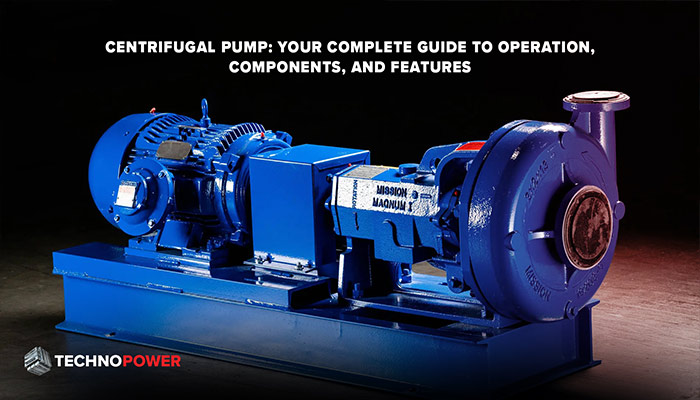تُعد مضخة الطرد المركزي من أهم أنواع المضخات المستخدمة في مختلف القطاعات الصناعية والزراعية والمنزلية. تعتمد هذه المضخات على مبدأ بسيط وفعّال لنقل السوائل بكفاءة عالية. في هذا الدليل، نأخذك في جولة شاملة للتعرف على كل ما يخص مضخة الطرد المركزي، بدايةً من مكوناتها الأساسية، مرورًا بمبدأ عملها، وصولًا إلى مميزاتها واستخداماتها.
ما هي مضخة الطرد المركزي؟
مضخة الطرد المركزي هي جهاز ميكانيكي يستخدم قوة الطرد المركزي لتحريك السوائل من مكان إلى آخر عبر دوران ريش المضخة بسرعة عالية. تُستخدم هذه التقنية بكفاءة عالية في أنظمة نقل المياه، والصناعات البترولية، ومحطات المعالجة، وحتى في الاستخدامات المنزلية.
للتعرف على أنواع أخرى من مضخات المياه المتوفرة، يمكنك زيارة موقع تكنوباور الرائد في هذا المجال.
أجزاء مضخة الطرد المركزي
تتكون مضخة الطرد المركزي من مجموعة من الأجزاء الأساسية التي تعمل بتناغم لتحقيق الأداء المطلوب. وتشمل هذه الأجزاء:
المكره (Impeller): القلب النابض للمضخة، وهي عبارة عن شفرات دوارة تقوم بتحويل الطاقة الميكانيكية إلى طاقة حركية، مما يؤدي إلى تسريع حركة السائل داخل المضخة ودفعه نحو فتحة الخروج.
غلاف المضخة (Casing): يغلف المكره ويوجه تدفق السائل. قد يأتي الغلاف بتصميم حلزوني أو دائري وفقًا لنوع المضخة، ويُعد مسؤولاً عن تحويل الطاقة الحركية للسائل إلى ضغط.
عمود الإدارة (Shaft): ينقل الطاقة من المحرك الكهربائي إلى المكره، مما يتيح لها الدوران بسرعة مناسبة لضخ السائل بكفاءة.
نظام الإغلاق (Seal System): يمنع تسرب السائل على طول العمود. يمكن أن يكون الإغلاق عن طريق أختام ميكانيكية أو أنظمة إحكام خاصة حسب تصميم المضخة.
المحامل (Bearings): تدعم حركة العمود وتقلل الاحتكاك أثناء الدوران، مما يحسن من كفاءة المضخة ويطيل عمرها التشغيلي.
أنظمة التبريد والتشحيم (Cooling and Lubrication Systems): تُستخدم خصوصًا في المضخات التي تعمل في بيئات عالية الحرارة أو ذات ضغط مرتفع، لضمان استمرارية الأداء دون تلف للأجزاء الداخلية.
أنابيب السحب والدفع (Suction and Discharge Pipes): مسؤولة عن إدخال السائل إلى المضخة وإخراجه منها بعد الضغط.
كل جزء في مضخة الطرد المركزي يؤدي دورًا حاسمًا لتحقيق الأداء المطلوب سواء في التطبيقات الصناعية، أو الزراعية، أو المنزلية.
عند التفكير في اختيار مضخة مناسبة، ينصح بالاطلاع أيضًا على أنواع أخرى مثل المضخات الغاطسة لأغراض محددة.
مبدأ عمل مضخة الطرد المركزي
يعتمد مبدأ عمل مضخة الطرد المركزي على الطاقة الحركية الناتجة عن دوران المكره. عند تشغيل المضخة:
يدخل السائل من فتحة الدخول إلى مركز المكره.
تدور المكره بسرعة عالية مما يخلق قوة طرد مركزي.
تُدفع السوائل إلى الخارج باتجاه حافة المكره.
تنتقل السوائل إلى فتحة الخروج تحت ضغط مرتفع.
بفضل هذا التصميم البسيط والفعّال، تستطيع مضخات الطرد المركزي التعامل مع كميات كبيرة من السوائل بكفاءة عالية.
مميزات مضخة الطرد المركزي
هناك العديد من المزايا التي تجعل مضخات الطرد المركزي خيارًا مفضلاً في العديد من التطبيقات:
تصميم بسيط وصيانة سهلة.
تكلفة منخفضة مقارنةً بمضخات أخرى.
كفاءة عالية في نقل السوائل.
توافر أنواع متعددة تناسب مختلف الاحتياجات.
إمكانية العمل في بيئات مختلفة بما في ذلك المياه النظيفة والمياه المشوبة.
للاستخدامات التي تتطلب تدفقًا عاليًا مثل نزح المياه، يمكنك مراجعة أفضل أنواع مضخة نزح المياه المتوفرة على موقع تكنوباور.
أنواع مضخات الطرد المركزي
الإجابة تشمل:
مضخات الطرد المركزي أحادية المرحلة: تستخدم لدورات ضغط منخفضة إلى متوسطة.
مضخات الطرد المركزي متعددة المراحل: تحتوي على أكثر من مكره لزيادة الضغط تدريجيًا، وهي مثالية لنقل السوائل لمسافات طويلة أو لارتفاعات كبيرة.
مضخات الطرد المركزي الأفقية: شائعة وسهلة الصيانة.
مضخات الطرد المركزي الرأسية: تستخدم عندما تكون المساحة الأفقية محدودة.
للتعرف أكثر على تفاصيل أنواع مضخات المياه يمكنك قراءة مقال أنواع مضخات المياه عبر موقع تكنوباور.
الفرق بين مضخة الطرد المركزي ومضخة الضغط العالي
بينما تقوم مضخات الطرد المركزي بنقل السوائل بكفاءة، فإن مضخات الضغط العالي تقدم قوة ضغط إضافية لتلبية الاحتياجات الخاصة بالتدفقات العالية والضغوط المرتفعة. يمكن التعرف على المزيد عبر مقال مضخات الضغط العالي.
الأسئلة الشائعة حول مضخة الطرد المركزي
ما الفرق بين مضخة الطرد المركزي ومضخة الغطس؟
مضخة الطرد المركزي تستخدم فوق مستوى السائل، أما الغاطسة فتعمل وهي مغمورة في السائل.
هل مضخات الطرد المركزي مناسبة لجميع أنواع السوائل؟
بشكل عام نعم، ولكن للسوائل ذات اللزوجة العالية قد تحتاج إلى مضخات خاصة.
ما هي صيانة مضخة الطرد المركزي الدورية؟
تشمل فحص المحامل، واستبدال الأجزاء التالفة، وضبط توازن المكره بشكل دوري.
متى أختار مضخة طرد مركزي متعددة المراحل؟
عندما تحتاج إلى نقل السائل إلى مسافات طويلة أو ارتفاعات عالية مع الحفاظ على الكفاءة.
خاتمة
في الختام، تُعد مضخة الطرد المركزي من أكثر المضخات استخدامًا بفضل كفاءتها وسهولة صيانتها وتكلفتها المناسبة. إذا كنت تبحث عن مضخات مياه عالية الجودة بمختلف أنواعها، فلا تتردد بزيارة موقع تكنوباور .


